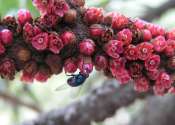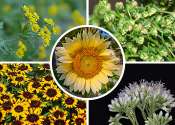A DNA sequence or genetic sequence is a succession of letters representing the primary structure of a real or hypothetical DNA molecule or strand, with the capacity to carry information as described by the central dogma of molecular biology.
The possible letters are A, C, G, and T, representing the four nucleotide bases of a DNA strand — adenine, cytosine, guanine, thymine — covalently linked to a phosphodiester backbone. In the typical case, the sequences are printed abutting one another without gaps, as in the sequence AAAGTCTGAC, read left to right in the 5' to 3' direction. Short sequences of nucleotides are referred to as oligonucleotides and are used in a range of laboratory applications in molecular biology. With regard to biological function, a DNA sequence may be considered sense or antisense, and either coding or noncoding. DNA sequences can also contain "junk DNA."
Sequences can be derived from the biological raw material through a process called DNA sequencing.
In some special cases, letters besides A, T, C, and G are present in a sequence. These letters represent ambiguity. Of all the molecules sampled, there is more than one kind of nucleotide at that position. The rules of the International Union of Pure and Applied Chemistry (IUPAC) are as follows:









